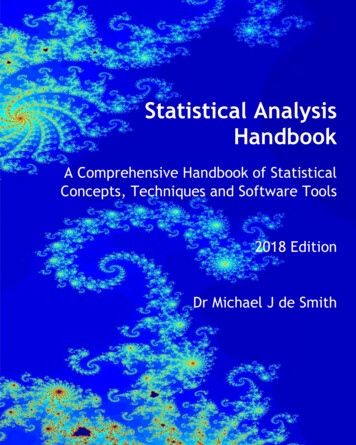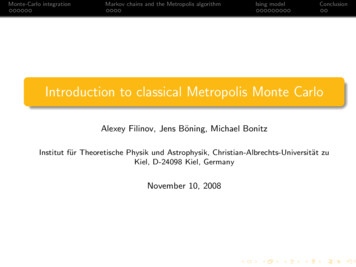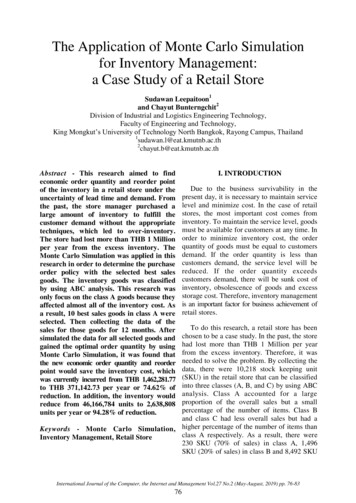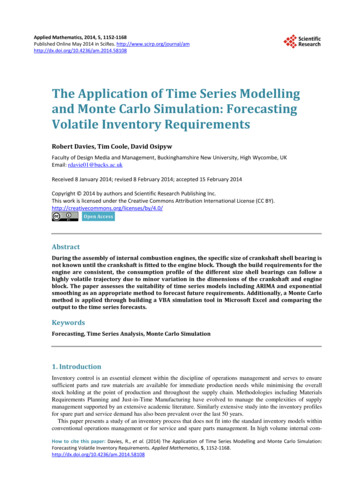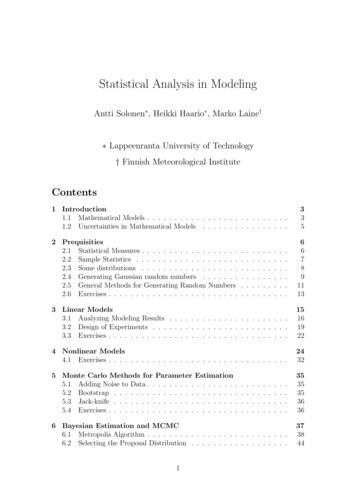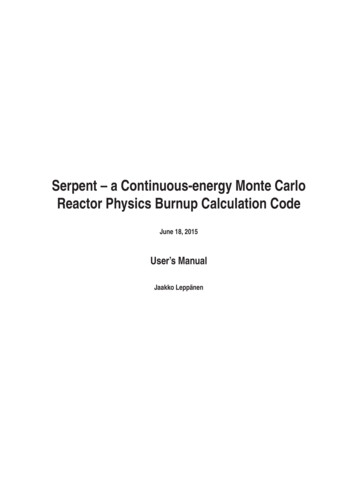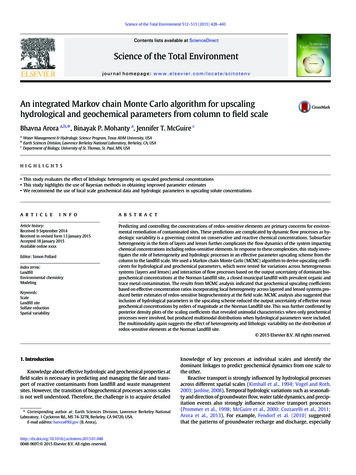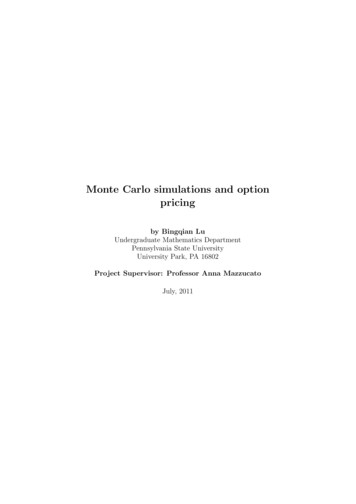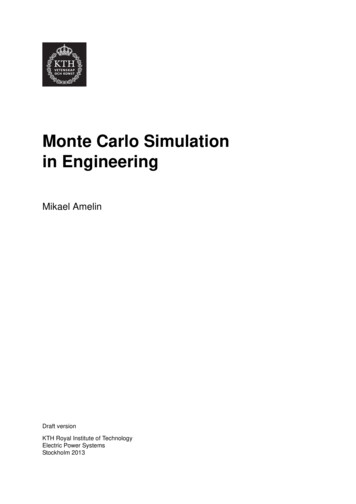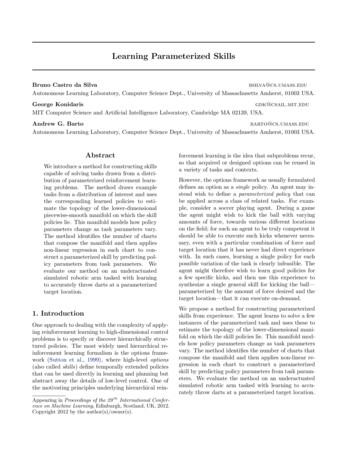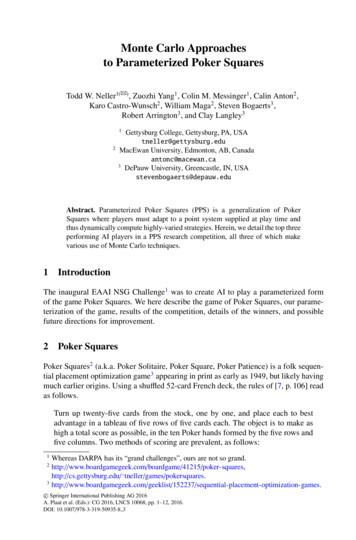
Transcription
Monte Carlo Approachesto Parameterized Poker SquaresTodd W. Neller1(B) , Zuozhi Yang1 , Colin M. Messinger1 , Calin Anton2 ,Karo Castro-Wunsch2 , William Maga2 , Steven Bogaerts3 ,Robert Arrington3 , and Clay Langley312Gettysburg College, Gettysburg, PA, USAtneller@gettysburg.eduMacEwan University, Edmonton, AB, Canadaantonc@macewan.ca3DePauw University, Greencastle, IN, USAstevenbogaerts@depauw.eduAbstract. Parameterized Poker Squares (PPS) is a generalization of PokerSquares where players must adapt to a point system supplied at play time andthus dynamically compute highly-varied strategies. Herein, we detail the top threeperforming AI players in a PPS research competition, all three of which makevarious use of Monte Carlo techniques.1 IntroductionThe inaugural EAAI NSG Challenge1 was to create AI to play a parameterized formof the game Poker Squares. We here describe the game of Poker Squares, our parameterization of the game, results of the competition, details of the winners, and possiblefuture directions for improvement.2 Poker SquaresPoker Squares2 (a.k.a. Poker Solitaire, Poker Square, Poker Patience) is a folk sequential placement optimization game3 appearing in print as early as 1949, but likely havingmuch earlier origins. Using a shuffled 52-card French deck, the rules of [7, p. 106] readas follows.Turn up twenty-five cards from the stock, one by one, and place each to bestadvantage in a tableau of five rows of five cards each. The object is to make ashigh a total score as possible, in the ten Poker hands formed by the five rows andfive columns. Two methods of scoring are prevalent, as follows:123Whereas DARPA has its “grand challenges”, ours are not so /poker-squares,http://cs.gettysburg.edu/ ation-games.c Springer International Publishing AG 2016 A. Plaat et al. (Eds.): CG 2016, LNCS 10068, pp. 1–12, 2016.DOI: 10.1007/978-3-319-50935-8 3
2T.W. Neller et al.HandEnglish AmericanRoyal flush30100Straight flush3075Four of a kind1650Full house1025Flush5201215Three of a kind610Two pairs35One pair12StraightThe American system is based on the relative likelihood of the hands in regularPoker. The English system is based on the relative difficulty of forming the handsin Poker Solitaire.You may consider that you have “won the game” if you total 200 (American)or 70 (English).Note that the single remaining Poker hand classification of “high card”, which doesnot fit any of the above classifications, scores no points.3 Parameterized Poker SquaresAs David Parlett observed, “British scoring is based on the relative difficulty of formingthe various combinations in this particular game, American on their relative ranking inthe game of Poker.” [9, pp. 552–553] We observe that different point systems give riseto different placement strategies.For example, in playing with British or American scoring, one often has a row andcolumn where one dumps unwanted cards so as to form higher scoring combinationsin the other rows and columns. However, a very negative score (i.e., penalty) for the“high card” category would discourage leaving any such row or column without a highprobability of alternative scoring.In our parameterization of Poker Squares, we parameterize the score of each of the10 hand categories as being an integer in the range [ 128, 127]. Given a vector of 10integers corresponding to the hand classification points as ordered in the table above,the player then plays Poker Squares according to the given point system.The goal is to design Poker Squares AI with high expected score performance acrossthe distribution of possible score parameters.4 Point SystemsContest point systems consisted of the following types.
Monte Carlo Approaches to Parameterized Poker Squares3– Ameritish - a randomized hybrid of American and English (a.k.a. British) point systems; includes American and English systems (given above)– Random - points for each hand category are chosen randomly in the range[ 128, 127]– Hypercorner - points for each hand category are chosen with equal probability from{ 1, 1}– Single Hand - only one hand category scores 1 point; all other categories score nopointsHand categories are decided according to the rules of Poker, with higher ranking hand categories taking precedence. Note that the high card hand category may beawarded points in non-Ameritish systems.4.1 Contest Structure and ResultsFor each point system tested in contest evaluation, each Java player program was giventhe point system and 5 min to perform preprocessing before beginning game play. Foreach game, each player was given 30 s of total time for play decision-making. A playertaking more than 30 s of total time for play decision-making or making an illegal playscored 10 times the minimum hand point score for the game.For each point system tested, each player’s scores were summed to a total score andthis total was normalized to a floating point number ranging from 0 (lowest score of allplayers) to 1 (highest score of all players). Players were ranked according to the sumof their normalized scores across all point system tests. All testing was performed ona Dell Precision M4800 running Windows 7 (64-bit) with and Intel Core i7-4940MXCPU @ 3.1 GHz, 32 GB RAM, and running Java version 1.8.0 51. Results of the contestcan be seen in Fig. 1.Fig. 1. Results of Contest EvaluationNon-fixed point systems were generated with contest random seed 34412016. Thetwelve point systems used for contest evaluation included American, Ameritish, British,
4T.W. Neller et al.Hypercorner, Random, and the following seven Single-Hand systems: High Card, OnePair, Two Pairs, Three of a Kind, Straight, Flush, and Full House.Detailed performance information is available online4 . Final contest standings wereas follows:1. Score: 11.821; Player: BeeMo; Students: Karo Castro-Wunsch, William Maga; Faculty mentor: Calin Anton; School: MacEwan University2. Score: 11.763; Player: GettysburgPlayer; Students: Colin Messinger, Zuozhi Yang;Faculty mentor: Todd Neller; School: Gettysburg College3. Score: 11.334; Player: Tiger; Students: Robert Arrington, Clay Langley; Facultymentor: Steven Bogaerts; School: DePauw University4. Score: 11.170; Player: JoTriz; Student: Kevin Trizna; Faculty mentor: David Mutchler; School: Rose-Hulman Institute of Technology5. Score: 7.149; Player: SRulerPlayer; Student: Zachary McNulty; Faculty mentor:Timothy Highley; School: La Salle University6. Score: 0.192; Player: MonteCarloTreePlayer; Student: Isaac Sanders; Faculty mentor: Michael Wollowski; School: Rose-Hulman Institute of Technology7. Score: 0.190; Player: DevneilPlayer; Student: Adam Devigili; Faculty mentor: BrianO’Neill; School: Western New England UniversityAs a benchmark, a random player was evaluated alongside contestants, scoring0.153 tournament points. We first note that a cluster of 4 players scored close to thetournament maximum possible score of 12. The two bottom entries scored only slightlybetter than random play.In the following sections, we will provide details of the top three performing players.5 BeeMoBeeMo implements a parallel flat Monte Carlo search guided by a heuristic which useshand patterns utilities. These utilities are learned through an iterative improvement algorithm involving Monte Carlo simulations and optimized greedy search. BeeMo’s development process was focused on three domains: game state representation, search, andlearning. For each of these domains, we investigated several approaches. In the following subsections, we present the best combination of approaches according to empiricalevaluations. For a more detailed description of all designs, see [4].5.1Game State RepresentationWe used a simple array representation for the tableau of face up cards and a bit packedrepresentation for the deck of face down cards. We implemented a hand encodingscheme based on hand patterns, which are a representation of hands which retains onlythe relevant hand information:– if the hand contains a flush - 1 bit;– if the hand contains a straight - 1 bit;4http://cs.gettysburg.edu/ tneller/games/pokersquares/eaai/results/.
Monte Carlo Approaches to Parameterized Poker Squares–––––5number of cards in the hand without a pair - 3 bits;number of pairs in the hand - 2 bits;if the hand contains three of a kind - 1 bit;if the hand contains four of a kind -1 bit;if the hand is a row - 1 bit.The hand pattern encoding was extended with contextual information about thenumber of cards of the primary rank and secondary rank remaining in the deck. Theseare the ranks with the largest and second largest number of repetitions in the hand,respectively. We also added information about the number of cards in the remainingdeck that can make the hand a flush. Instead of actual number of cards we used a coarseapproximation with three values: not enough cards, exactly enough cards, and morethan enough cards remaining to complete a certain hand. The approximation is represented on 2 bits, and so the contextual information adds 6 extra bits to the hand pattern,for a total of 16 bits for hand pattern and contextual information. The extra information increases the number of empirically observed unique patterns by a factor of 10.Our experiments indicate that this added complexity is overcome by the significantimprovement in training accuracy.5.2 SearchWe implemented several game tree search algorithm classes: rule based, expectimax,greedy, and Monte Carlo. We compared their performance using a crafted heuristicfor the American scoring system. Our empirical analysis indicated that the best searchalgorithms belong to the Monte Carlo and Greedy classes. As the final agent uses a combination of flat Monte Carlo and optimized greedy, we will present our implementationof these algorithms.Optimized Greedy implements a greedy strategy based on hand pattern utilities.Every new card placed on the tableau of face up cards, influences only two hands: thecolumn and the row in which the card is placed. Thus, the value of placing the card inany position can be estimated by the sum of the changes of the values for the columnhand and for the row hand. The change in every hand is the difference of the handpattern utility after and before placing the card. The optimized greedy algorithm placesthe card in the position that results in the largest value. Computing these values is veryfast as it needs four look ups in a hash table of hand pattern utilities, two subtractionsand an addition. It is exactly this simplicity that makes the algorithm very fast.The algorithm plays ten of thousand of games per second, has impressive performances (consistently scores over 115 points on the American scoring), and it is essentially the same for any scoring system - the only changes are in the hand pattern utilities’hash table entries.Flat Monte Carlo is a variation of the imperfect information Monte Carlo [5]. Ata given node, the algorithm evaluates each child by averaging the scores of a largenumber of simulated games from that child, and then selects a move that results in thechild with the largest value. Any search algorithm can be used to guide the simulatedgames, but a fast one is preferable. For this reason we used the optimized greedy searchfor the simulated games.
6T.W. Neller et al.The resulting algorithm consistently outperformed optimized greedy by a marginof 10 points on the American scoring. However, the time efficiency of the algorithmwas significantly worse than that of optimized greedy. Parallelization improved thealgorithm speed significantly. In its final implementation the algorithm creates severalthreads of game simulations which are run in parallel on all available cores. Despitebeing an order of magnitude slower than the greedy algorithm, the parallel flat MonteCarlo is fast and has the best score performances of all the algorithms we tried.5.3LearningBecause the scoring scheme is not known, learning the partial hand utilities is the mostimportant part of the agent. We used Monte Carlo simulations for learning the handpattern utilities. The learning algorithm uses rounds of 10,000 Monte Carlo simulations,5,000 for training and 5,000 for evaluation.All hand pattern utilities are initialized to zero. At the end of a training game, thevalue of each final hand is recorded for every hand pattern which resulted in the hand.For example, if a partial hand has only a 5 and at the end of the game results in a flushwith a score of 20, then a value of 20 is recorded for the pattern which encodes a handwith only 5 . The utility of a hand pattern is estimated as the average of all recordedvalues. The updated hand pattern utility set is used in the next simulated game.Using flat Monte Carlo search for the training phase, the agent learned hand patternutilities which for the American scoring resulted in performance comparable to thoseobtained using the crafted hand pattern utilities, and reduced running time.While simple and fast, flat Monte Carlo search suffers from lack of specialization.When used for learning hand pattern utilities this drawback negatively affects the accuracy of the estimations. For example, low frequency patterns with high utilities arerarely updated and thus the learned values may be unreliable. To check if our learning algorithm has such a pitfall we implemented a UCT evaluation scheme inspired bythe UCB1 variation of the Upper Confidence Bound [2]. We used a small explorationparameter which was optimized empirically. UCB1 slightly increased the number ofdiscovered patterns, but its influence on agent’s performance was positive only for theAmerican and British scoring systems. For the final agent we decided to use both evaluation schemes by alternating them with different frequencies.In the evaluation phase, 5,000 simulated games are played using the set of handpattern utilities learned in the training phase. The average of the games’ scores is usedto evaluate the overall utility of a set of patterns. The set with the highest overall utilityis used by the final agent. The agent consistently completes 180 rounds of learningduring the allowed 300 s. However, most of the improvements are done in the first 10rounds, after which the performance evolution is almost flat.As indicated in the contest results, the final agent played strongly under all scoringsystems. Given that (1) players employed various heuristics and differing uses of MonteCarlo techniques, and (2) players achieved similar peak performance, we conjecture thatthese top players closely approximate optimal play.
Monte Carlo Approaches to Parameterized Poker Squares76 GettysburgPlayerThe GettysburgPlayer uses a static evaluation, which abstracts game states and attemptsto assess their values given any scoring system, in combination with expectimax searchlimited to depth 2.6.1 Static EvaluationThe total state space is too large to evaluate in advance, so the state space is abstractedand on-policy Monte Carlo reinforcement learning is applied in order to simultaneously improve estimates of the abstracted game and improve play policy that guidesour Monte Carlo simulations.Abstracting Independent Hands. Our Naı̈ve Abstract Reinforcement Learning(NARL) player abstracts the state of each independent row/column and learns theexpected value of these abstractions through Monte Carlo -greedy reinforcement learning. Each hand abstraction string consists of several features which we consideredsignificant.– Number of cards played in the game so far– Indication of row (“-”) or column (“ ”)– Descending-sorted non-zero rank counts and how many cards are yet undealt in eachof those ranks appended to each parenthetically– Indication of whether or not a flush (“f”) is achievable and how many undealt cardsare of that suit– Indication of whether or not a straight (“s”) is achievable– Indication of whether or not royal flush (“r”) is achievableFor example, “14 1(3)1(2)1(2)f(8)s” represents a column hand abstractionafter the 14th move. There is one card in each of three ranks, two of which have twoof that rank undealt and one has three undealt. A flush is achievable with eight cardsundealt in that suit. A straight is achievable and a royal flush is not.During Monte Carlo reinforcement learning, such hand abstractions are generatedand stored in a hash map. Each abstraction maps to the expected hand score and numberof occurrences of the hand. These are continuously updated during learning. By storingthe expected scores of each row/column complete/partial hand, the hash map allows usto sum scoring estimates for each row and column, providing a very fast estimate ofthe expected final score of the game grid as a whole. Note that this naı̈vely assumes theindependence of the hand scoring estimates.Raising Proportion of Exploration Plays. During the Monte Carlo reinforcementlearning stage, we use an -greedy policy with a geometric decay applied to the parameter. Thus for most of time the player chooses an action that achieves a maximalexpected score, but also makes random plays with probability .In our initial application of -greedy play, 0.1 with geometric -decayδ 0.999975 per simulated game iteration. However, we empirically observed that
8T.W. Neller et al.if we significantly raise the initial value of to 0.5, increasing initial exploration, theplayer has a better performance.In addition, the time cost for random play is much less than greedy play, so increasing the proportion of random plays increases the number of overall learning iterationsper unit time. Empirically, this relatively higher will not only raise the number ofexploration plays but also will be able to leave sufficient time for exploitation plays.However, purely random play makes certain types of hands highly improbable (e.g.,royal flush, straight), so sufficient exploitation-heavy play time is necessary to learn thevalue of long-term attempts to achieve such hands.Considering Frequency of Partial Hand Sizes. We observed our player’s behaviorand found that it tended to spread cards evenly among rows and columns in the earlyand middle stages of the game. The reason for this behavior is that the player is makinggreedy plays that maximize expected score gain. In a pre-evaluation between NARL andanother player developed earlier that performed better under the single-hand Two Pairspoint system, we observed that with same card dealt, NARL tended to set up one pairevenly among rows and columns according to the assumption of hand independence,while the comparison player appeared to gain an advantage by preferring to focus ondeveloping a row/column with a pair and two single cards early.Based on this observation, we added the current distribution of hand sizes to theabstraction. The number of cards played in each row and column are tallied, and wesummarize the distribution in a hand size frequency vector represented as a string.For instance, the string “721000” represents a grid hand size distribution after the 2ndmove. (The number of cards dealt can be inferred from the abstraction.) The zero-basedindex of the string corresponds to hand size in a row/column. Thus, “721000” indicatesthat there are seven empty hands, two with one card, one with two cards, and none withmore than two.The previous grid hand abstraction is trained together with hand size abstractionto learn the difference between the final score and expected score at each of the 25states across the game. In practice, we find that adding this abstraction feature generallyimproves performance for some simpler point systems.Experiments and Data. We experimented with 3 players, all of which used -decayδ 0.999975. The first used an initial epsilon 0 0.1, whereas the second and thirdused 0 0.5. Only the third player incorporated the hand size frequency abstractionfeature.For each random point system (the Ameritish point system, Random point system,Hypercorner point system) we generated a sample of 500 systems and measured theaverage greedy-play performance of 2000 games for each player and system. For fixedpoint systems, we collected average performance of 2000 games for each player andsystem. For each point system, performance was scaled between 0 and 1 as with thepreviously described tournament scoring (Fig. 2).
Monte Carlo Approaches to Parameterized Poker Squares9Fig. 2. Comparison of learning evaluation performance. NARL with 0 0.5 performed best formost point systems.6.2 Search AlgorithmUsing the NARL static evaluation, we compared three search algorithms: (1) FlatMonte Carlo [3, Sect. 2.3] limited to depth 5, (2) Flat UCB1 limited to depth 5 andmultiplying the exploration term 2ln(n)/n j by 20 to encourage greater exploration5 ,and (3) expectimax with a depth limit of 2.The three algorithms were paired with the three static evaluators and tested againsteach other using the contest software, 8 scoring systems, and the seed 21347. Eachplayer ran 100 games per point system. The final comparison was based upon eachplayer’s total normalized score. A combination of depth 2 expectimax and the NARLevaluator ( 0 0.5) received the highest total score and was submitted for competition.Significance testing of the various player components revealed that our static evaluation function was most significant to the player’s performance [8]. Space limitationspreclude the full set of alternative designs considered. However, these and relevantexperimental data are available in [8] as well.7 Tiger: A Heuristic-Based MCTS PlayerThis summary is based on a more detailed discussion available in [1]. The player usesMonte Carlo Tree Search (MCTS) [3] with added domain knowledge to select moves.7.1 Design and Application of the State HeuristicThis player includes a state heuristic that can accommodate any scoring system. It canbe framed as ten applications of a hand heuristic, corresponding to the ten rows and5The factor of 20 was chosen through limited empirical performance tuning. It is not necessarilyoptimal for this problem.
10T.W. Neller et al.columns in the game. Five-card hands are simply scored according to the current scoringsystem. One to four card hands, however, are evaluated with probability estimates.In four-card hands, for each hand type, a weight in [0, 1] is calculated, representingan estimated likelihood of obtaining that hand type with the next card draw given thecards remaining in the deck. For example, suppose a 4-card hand contains a 6 , 6 , 6 ,and 7 , while the deck contains only a 6 , 7 , and 8 . Here, three-of-a-kind is given aweight of 1/3 because among the remaining cards only 8 would result in three-of-akind. Once these weights are calculated for every hand type, each weight is multipliedby the hand type value according to the current scoring system, and added together toform a weighted sum. Note that this ignores the fact that the ten hands in the grid aredependent on each other, both spatially and in “competition” for cards.This approach gets much more computationally intensive for hands with fewer thanfour cards, and so in this case we instead use estimated a-priori probabilities of handtypes as weights. These probabilities are then used to compute a weighted sum in thesame way as in a four-card hand. Note, however, that by this measure hands with fewercards will be inadvertently favored, because fewer cards will tend to mean more possiblehand-types. To counter this, we apply weights α, β, and γ to one, two, and three-cardhand heuristic values, respectively. For now, we fix these values at α 0.2, β 0.4,and γ 0.6, with tuning experiments described below.With this heuristic, various selection strategies exist. UCT [6] is a standard measurebalancing exploration and exploitation with no domain-specific heuristic. Best Movealways chooses the single unexplored node with the highest heuristic value. Prune UCT prunes nodes below a heuristic score threshold and then applies standard UCT.In simulation, Random is the standard MCTS strategy of choosing random moveswithout a heuristic. Prune Random chooses moves at random from a tree pruned viathe heuristic. Best Move chooses the single move with the highest heuristic value.7.2Experiments and ResultsTable 1 shows results for various experiments. We begin by considering the practicalcost of calculating the heuristic itself, since time spent on heuristic calculations meansfewer iterations of the core MCTS process. Row (1) reflects standard MCTS, with UCTselection and Random simulation. Rows (2) – (4) also use these standard strategies,but with the “ Calc.” notation indicating that the heuristic calculations are performedbut not actually applied. Note a total cost of 13 points (comparing rows (1) and (4))in the American scoring system when the heuristic is calculated in both selection andsimulation, with most of the cost coming from simulation.In simulation, ignoring for now the “Tuned” column, note that Prune Random’sscore of 95 (row (5)) shows improvement over the 92 of standard MCTS (row (1)) andthe 80 of the added heuristic calculation cost (row (3)). Best Move simulation (row(6)) improved more strongly to an untuned score of 112. It seems intuitive that BestMove simulation is more effective than Prune Random, since Best Move plays asimulated game according to the best choices that the heuristic is capable of suggesting.In contrast, Prune Random gives the heuristic less control, only determining a set ofhigher-scoring moves from which a random selection is made.
Monte Carlo Approaches to Parameterized Poker Squares11Table 1. Mean scores over 2,000 games for various selection and simulation strategiesRow SelectionSimulationUntuned Tuned(1)(2)(3)(4)UCTUCT CalcUCTUCT CalcRandomRandomRandom CalcRandom Calc92908079(5)UCTPrune Random95(6)UCTBest Move(7)Best MoveRandom(8)Prune UCT Random(9)Prune UCT Best Move112118729194113123Next consider the selection strategy results, again ignoring for now the “Tuned”column. Prune UCT seems unhelpful when comparing rows (1) vs. (8), and (6) vs. (9)(untuned). The final set of experiments will consider this further. Best Move selection,in contrast, appears not merely unhelpful but harmful. With a score of 72 (row (7)), itscores even worse than row (2) in which the calculations are performed but not applied.This is not surprising, since such a drastic approach severely limits the number of nodesavailable for exploration. That is, while Best Move simulation is a useful limitation incontrast to Random simulation, the more principled exploration of selection with UCTshould not be so severely restricted by a Best Move approach.Finally, consider further tuning of α, β, and γ values for weighting one-, two-, andthree-card hands, respectively. After experiments on many combinations of settings, itwas found that α 0.1, β 0.3, γ 0.85 gave the best performance on the Americanscoring system, with other high-scoring settings converging on those values. Resultsfor this setting are shown in the “Tuned” column of Table 1. This newly-tuned heuristicsheds new light on Prune UCT selection, which seemed ineffective in the untunedresults. Row (8) shows that Prune UCT selection with tuned parameter settings attainsa 94, compared to the 91 with the untuned settings, and the 92 (row (1)) of standardMCTS. Similarly, Best Move simulation now scores 118 (row (6)), showing furtherimprovement over the untuned 112. These experiments demonstrate that both Prune UCT selection and Best Move simulation can be improved and are worthwhile aftertuning the heuristic, with a final top score of 123 when both strategies are applied.8 ConclusionThe inaugural EAAI NSG Challenge was reported to be a very positive experience byboth students and faculty. Informal evaluation indicates that more than half of entriesperform well beyond human-level play, and most were densely clustered at the top ofthe distribution, lending confidence to a conjecture that optimal play is not far beyondthe performance observed.
12T.W. Neller et al.In the future, it would be interesting to perform more significance testing acrossimplementations in order to demonstrate the relative value of different design components, e.g., the parallelization of BeeMo. Testing comparable elements of designs wouldguide a hybridization of approaches, e.g., testing a single search algorithm with eachof our various static evaluation functions. We conjecture that an ensemble or hybridapproach would yield performance improvements.References1. Arrington, R., Langley, C., Bogaerts, S.: Using domain knowledge to improve monte-carlotree search performance in parameterized poker squares. In: Proceedings of the 30th NationalConference on Artificial Intelligence (AAAI 2016), pp. 4065–4070. AAAI Press, Menlo Park(2016)2. Auer, P., Cesa-Bianchi, N., Fischer, P.: Finite-time analysis of the multiarmed bandit problem.Mach. Learn. 47(2–3), 235–256 (2002). http://dx.doi.org/10.1023/A:10136897043523. Browne, C., Powley, E., Whitehouse, D., Lucas, S., Cowling, P.I., Rohlfshagen, P., Tavener,S., Perez, D., Samothrakis, S., Colton, S.: A survey of Monte Carlo tree search methods. IEEETrans. Comput. Intell. AI Games 4(1), 1–49 (2012). pdf4. Castro-Wunsch, K., Maga, W., Anton, C.: Beemo, a Monte Carlo simulation agent for playingparameterized poker squares. In: Proceedings of the 30th National Conference on ArtificialIntelligence (AAAI 2016), pp. 4071–4074. AAAI Press, Menlo Park (2016)5. Furtak, T., Buro, M.: Recursive Monte Carlo search for imperfect information games. In: 2013IEEE Conference on Computational Inteligence in Games (CIG), Niagara Falls, ON, Canada,11–13 August 2013, pp. 1–8 (2013). http://dx.doi.org/10.1109/CIG.2013.66336466. Kocsis, L., Szepesvári, C., Willemson, J.: Improved monte-carlo search. Univ. Ta
2 Poker Squares Poker Squares2 (a.k.a. Poker Solitaire, Poker Square, Poker Patience) is a folk sequen-tial placement optimization game3 appearing in print as early as 1949, but likely having much earlier origins. Using a shuffled 52-card French deck, the rules of [7, p.106] read as follows.
